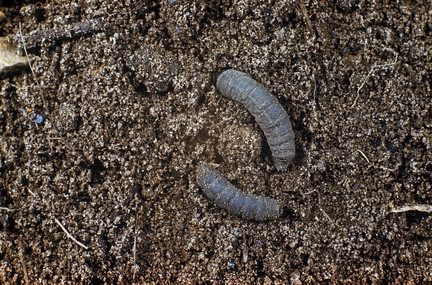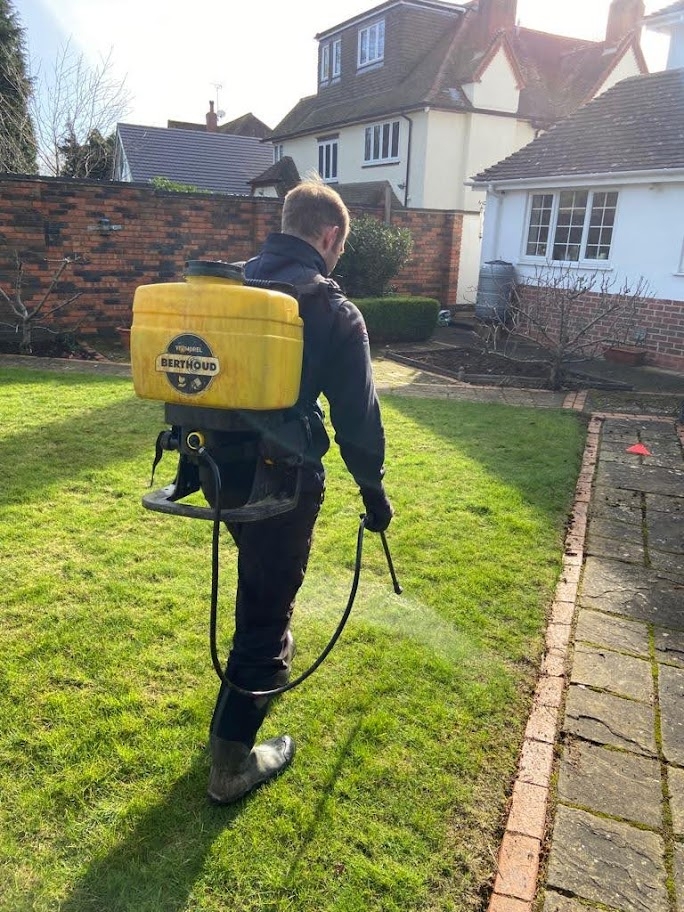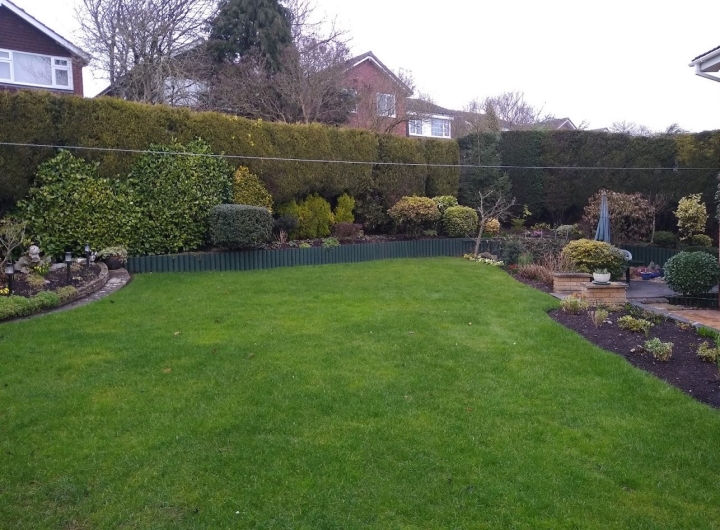NEWS - Leatherjacket Control for Lawn Care
Following rigours testing and success in other fields of use such as golf, a new product has been authorised for use in professional lawn care for the control of leatherjackets and chafer grubs. These lawn pests have given us the run-around for a while now, so having this additional option is fantastic news. We won't be reaching for the bottle without consideration though....
Lawn Care - What are Leatherjackets?
Leatherjackets are the larvae of the crane fly (daddy long legs). In small populations, you are unlikely to notice any activity in your lawn. In larger populations they become problematic quickly. These lawn pests eat the roots of your lawn as their source of food.
Often worse is the secondary damage which can then follow – these grubs are the prey of birds, badgers and foxes. With a lack of rooting turf will often pull apart easily to reveal leatherjackets feeding in the rootzone.
All lawns will have some leatherjackets - this is normal and can be tolerated in most instances. What we are seeking to avoid is an infestation and as with many things in lawn care, prevention is better than cure.

How can I make my lawn less prone to a leatherjacket attack?
The adult crane fly will seek areas which are damp to lay eggs primarily in late August and September. Whereas we are not aware of products tested to deter the adult crane fly, aerated, draining soil on a well maintained lawn will help make the lawn both less susceptible to attack and able to within stand a small to moderate leatherjacket population. Often, healthy lawns will have leatherjackets without the homeowner or lawn care professional knowing!
- Frequent mowing will create a dense grass sward
- Aeration boosts root health, overall mass and surface drainage
- A nutrition programme further boosts health and recovery
- Scarification keeps thatch levels under control
Professional Leatherjacket Control - Acelepryn
What: This is a chemical control which has been newly authorised for use in the lawn care industry following use on airfields and golf courses only in recent years.
How: This liquid, when applied into the soil, effects the muscles of the grub, causing paralysis. This only works on the youngest of grubs and lasts in the soil for a period of two months.
When: With the above considered, it is vital that this application is made during ‘peak flight’ of the adult cranefly when eggs are being laid. This is across September.
By law, this product can only be used once per year, so we will only apply the insecticide during this window where is it going to gain the best return on investment. The considerations we make surrounding this product are vital due to our commitment to being as environmentally friendly as possible, and also the return we gain for our customers.

Acelepryn - Pre and Aftercare
- The product must reach the soil. This may require prior scarification for the best results if your lawn has a thatch layer. This could be from ourselves within one of our mechanical calls, or completed by yourself.
- Cut the lawn prior to application
- Water the lawn following application
- Mulch the clippings (cut with the box off) for the next two weeks. Any of the product that isn’t already washed into the soil will be coated on the grass leaves. We don’t want to remove these – the leatherjackets will feed on these clippings. With this in mind, you may need to increase your mowing frequency to keep the lawn tidy.
Pitfalls: Remember the product can only target the youngest grubs. This will be effective with the above followed, but it will have no impact on the larger grubs, and will not prevent adults from laying eggs in future seasons. It will cause disruption to their lifecycle, but will not eliminate the grubs or stop possible return.
DIY Option: Nematodes
What: This is a biological control which has been the only control for leatherjackets in recent years. Given this is a living, biological product it means that no pesticide certification is required to purchase or use.
How: The microscopic nematodes infect the leatherjackets. Once inside, they release bacteria that stops the pest from feeding. Given their microscopic size, getting them into the soil (a lot of watering!) to seek out the leatherjackets is the biggest challenge. This product only works on the adolescent leatherjackets. A soil temperature of 12c+ is required for nematodes.
When: With the above considered, mid-September to early October (14-21 days following Acelepryn) is the ideal timing for maximum impact for your time and money.


A back lawn in Warwick that was suffering badly from leatherjackets, before nematode treatment from the homeowner, followed by our lawn renovation.
Nematodes - Pre and Aftercare
- The product must reach the soil. This may require prior scarification for the best results if your lawn has a thatch layer. This could be from ourselves within one of our mechanical calls, or completed by yourself.
- Cut the lawn prior to application
- Water the lawn well prior to application
- Do not apply during direct sunlight
- Water the lawn 2-3 times daily for 2 weeks following application. Keep the lawn as close to saturated as possible to act as the carrier for the product.
Pitfalls: Remember the product can only target the adolescent grubs. This will be effective with the above followed, but it will have no impact on the larger grubs, and will not prevent adults from laying eggs in future seasons. It will cause good disruption to their lifecycle, but will not eliminate the grubs or stop possible return.
- The product must be kept refrigerated
- There is a limited lifespan. When purchased, use when possible
- Cannot be applied during direct sunlight. Look for an evening in September / October ideally with rain forecast
- Watering and more watering
Five steps for the best results against Leatherjackets:
1) Encourage healthy grass
A lawn treatment programme, along with annual aeration, will minimise damage from a small leatherjacket population, keeping the lawn as healthy as possible. A healthy, strong, deeply rooted lawn can cope with limited grubs and re-grow the lost root mass.
2) Black plastic sheeting
To check if there are grubs, or in smaller areas, you may be able to encourage them to the surface using black plastic sheets, tarpaulin or thick bin bags.
Firstly, thoroughly wet an infected area. Lay the thick sheeting (nothing that lets light through) over the top, secured down. Leave overnight, or for a couple of days. Remove early morning where there should be grubs on the surface of the lawn. These can be picked / brushed out of the lawn for breakfast for the birds!
3) Use of a biological control - Nematodes
A Google search of ‘Nematodes for Leatherjackets’ will provide you with online sellers. These can be ordered ahead of time with suppliers prior to harvest - but be aware of the delivery date that you want these for.
They are not a cheap product, so also consider the pack size / m2 worth that is required for your lawn. Given this is a biological control, these by law can be ordered and applied safely by a homeowner or gardener.
4) Use of a chemical control - Acelepryn
As discussed, reaching for a chemical control is our last resort when looking to control lawn pests. However, when required, this product, applied in conjunction with other methods of prevention and control, will yield the best results.
5) Bring a lawn treatment specialist on board
We've long advocated that having the right lawn care specialist to work in partnership with is more than just products and applications -it's actually about having the correct advice at the right time. For example, it may be chafer grubs that are the issue and you are applying the wrong nematodes for their control.
Can we help?
The control of lawn pests has been a frustration for the lawn care industry as a whole in recent years. We believe in being upfront with our customers and sharing the facts stated above, rather than over-promising thanks to a mystery magic product that isn't going to gain results. It's great that we're now able to help homeowners with this issue rather than being able to give advice only.
If we can help with your lawn this year, then please feel free to get in touch via the contact form below, or you can call us on 01827 826123.
